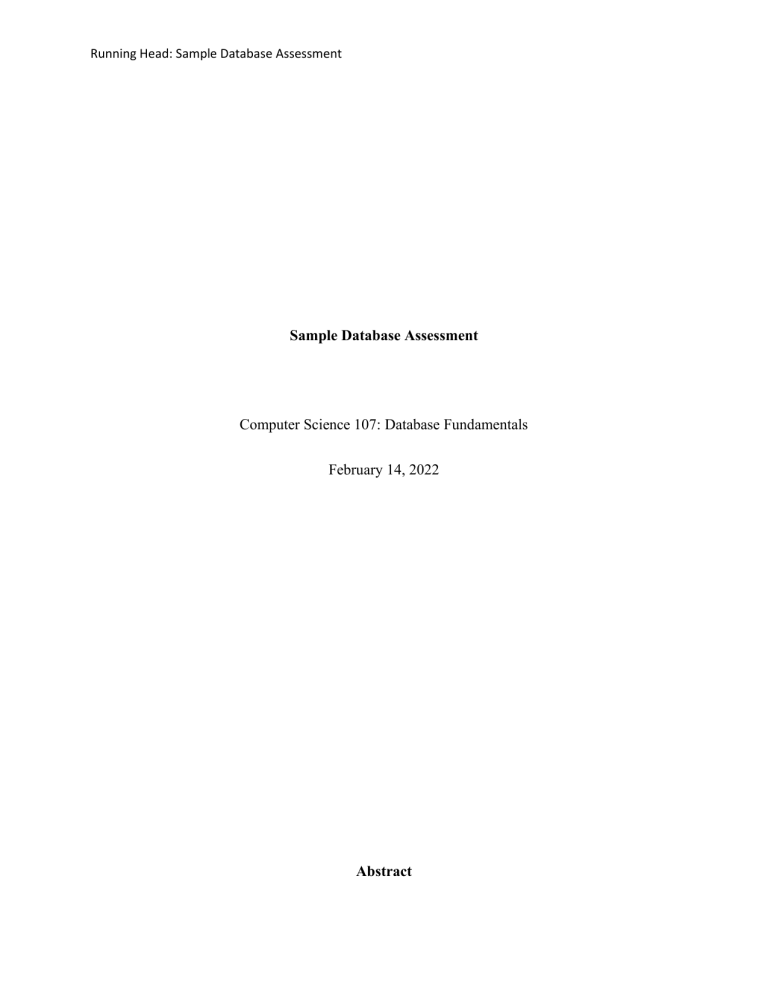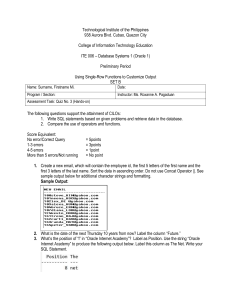
Running Head: Sample Database Assessment Sample Database Assessment Computer Science 107: Database Fundamentals February 14, 2022 Abstract Sample Database Assessment 1 A sample database was provided for analyses. The three areas the database was analyzed on were the version, the normalization level, and the keys and dependencies. After analysis it was determined that the version of the database is Oracle, the levels included in the database are levels one and two, and that the main keys include ITEMID and SUPPLIERID. More information on how the keys were utilized will be explained in detail below. Sample Database Assessment Sample Database Assessment 2 Intro Based on the database provided conclusions can be made regarding the following topics. The version of the database, the normalization level and the chosen keys and dependencies used in the given database. Because no demonstration is given for the intended function of this database assumptions must be made in order to analyze the data. Version of Database and SQL This database uses the “CHAR()” function to declare unique fixed-length character sets when creating the database. Size is declared at the inception of the database when a table is created with a CHAR column (Oracle, n.d.-a). Additionally the NUMBER data type is also used in this table in the form of Number(p, s) where p stands for precision and s stands for scale. This allows the oracle database to store the values according to the parameters set instead of the actual input improving the integrity of the database (Oracle, n.d.-b). The previous statements point toward the database version being Oracle. Database Levels of Normalization The criteria used to determine whether a table is in first normal form (1NF) include the following: 1) Each column must only contain a single value 2) Each columns name must be unique 3) Values of the given attribute must have the same data type 4) No two records are allowed to be identical (First Normal Form in DBMS with Examples, 2020). By looking at the tables all 5 of the tables meet these criteria. Assuming based on the explanations above that ITEMID is a Primary Key this makes the values unique to each table within the oracle database. For a table to be in second normal form (2NF) it must meet all the criteria for a 1NF table and no partial dependencies of any column on the primary key should exist (What is Normal Form in Sample Database Assessment 3 DBMS? - Types & Examples, 2017). The only table that meets these requirements is the Purchases table because no dependencies exist for this table. The other four tables did not meet the requirements for 2NF because dependencies existed for ITEMID in each of these tables. In order to meet the criteria for third normal form (3NF) a table must meet all requirements for 2NF, the non-primary fields in the table must be dependent on the primary field and all transitive dependencies must be removed (What is Normal Form in DBMS? - Types & Examples, 2017). The purchases table is disqualified from being 3NF because it still contains transitive dependencies. Keys and Dependencies A Primary Key provides an unconditional reference point to a record on a row. This is important when managing large collections of data and when there is a need to keep information separate. For a key to be primary it must be a unique identifier that correlates to a specific record in a database (What is a Primary Key in SQL?). In this database ITEMID acts as the Primary Key for Animal Products, Grains, and Produce tables. While SUPPLIERID acts as the Primary Key for the Suppliers table. Foreign keys are useful because they allow tables to draw in data from other tables. For a key to be a foreign key it must directly identify another table (What is a Foreign Key in SQL?). In this database ITEMID acts as a Foreign Key in the purchases table and SUPPLIERID acts as foreign key in Animal Products, Grains, and Produce tables. This allows these tables to update whenever a change is made using the Foreign Key. Citations Sample Database Assessment 4 First Normal Form in DBMS with Examples. (2020, March 16). Retrieved from https://study.com/academy/lesson/first-normal-form-in-dbms-with-examples.html. Oracle. (n.d.). CHAR Data Type. Retrieved February 17, 2022, from https://docs.oracle.com/en/database/oracle/oracle-database/21/sqlrf/DataTypes.html#GUID-85E0A0DD-9E90-4AE1-9AD5-93C89FDCFC49 Oracle. (n.d.-b). Number Data Types. Retrieved February 17, 2022, from https://docs.oracle.com/en/database/oracle/oracle-database/21/sqlrf/DataTypes.html#GUID-75209AF6-476D-4C44-A5DC-5FA70D701B78 "What is a Primary Key in SQL?" Study.com, 28 June 2016, study.com/academy/lesson/what-isa-primary-key-in-sql.html What is Normal Form in DBMS? - Types & Examples. (2017, December 30). Retrieved from https://study.com/academy/lesson/what-is-normal-form-in-dbms-types-examples.html.



